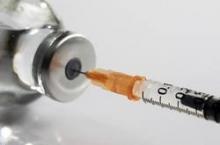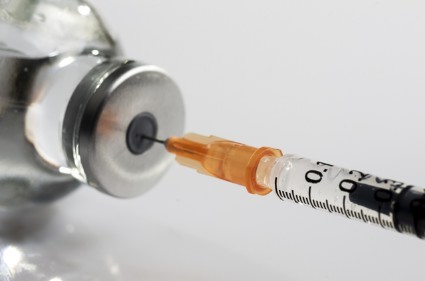User login
ATLANTA – The annual incidence of genital warts declined by 69% between 2006 and 2013 at a large public university after human papillomavirus vaccination was available, despite a relatively low intake among adolescents and college students less than 18 years old.
The proportion of students diagnosed with genital warts at a health center at the University of Wisconsin, Madison, in 2006 was 1.3% (222 students), compared with 0.5% (88 students) in 2013, Craig M. Roberts reported in a late-breaking poster at a conference on STD prevention sponsored by the Centers for Disease Control and Prevention.
About 90% of cases of external genital warts are caused by HPV types 6 or 11, which are included in the quadrivalent HPV vaccine that was licensed in the United States in 2006.
In this study, genital warts were used as a surrogate marker for HPV infection. The incidence declined each year from 2008 to 2013, noted Mr. Roberts, an epidemiologist and clinical assistant professor at the University of Wisconsin.
Among students entering the university between 2006 and 2013, 64% of women but only 15% of men reported receiving at least one dose of HPV vaccine. Despite the large difference in vaccination coverage, the reduction in the incidence of genital warts was similar between genders (75.7% for women and 67.6% for men).
In 2006, the overall incidence of genital warts was 15.7 per 1,000 (10.8 for women and 26.0 for men), compared with 4.8 per 1,000 (2.6 for women and 8.4 for men) in 2014.
The rates of vaccine completion did, however, increase each year between 2006 and 2013, Mr. Roberts noted. Vaccine uptake among women was 58.5% in 2006 and 69.7% in 2013; vaccination among men was 0.5% in 2006 and 36.9% in 2013.
The findings were based on a review of medical records for visits to the health center between January 2008 and December 2013. The data were compared with baseline records from 2006. Only initial genital warts diagnoses were included in the analysis.
"These data demonstrate the striking decreases in the incidence of genital wart diagnoses in a population of college students after the introduction of a quadrivalent HPV vaccine in the United States. Declines occurred rapidly over 7 years in this population of sexually active young adults, despite less than optimal levels of vaccine coverage," Mr. Roberts wrote.
The findings suggest that cross-protection for male partners occurred as immunization rates increased among women; the incidence in men began to decline even before a recommendation for HPV vaccination for men was in place.
The findings were limited by the study design, and by the possibility that students may have been diagnosed in settings other than the student health center. However, the results suggest that colleges and universities should continue to promote and provide HPV vaccine to students to achieve further reductions in disease incidence, Mr. Roberts concluded.
Mr. Roberts reported having no disclosures.
ATLANTA – The annual incidence of genital warts declined by 69% between 2006 and 2013 at a large public university after human papillomavirus vaccination was available, despite a relatively low intake among adolescents and college students less than 18 years old.
The proportion of students diagnosed with genital warts at a health center at the University of Wisconsin, Madison, in 2006 was 1.3% (222 students), compared with 0.5% (88 students) in 2013, Craig M. Roberts reported in a late-breaking poster at a conference on STD prevention sponsored by the Centers for Disease Control and Prevention.
About 90% of cases of external genital warts are caused by HPV types 6 or 11, which are included in the quadrivalent HPV vaccine that was licensed in the United States in 2006.
In this study, genital warts were used as a surrogate marker for HPV infection. The incidence declined each year from 2008 to 2013, noted Mr. Roberts, an epidemiologist and clinical assistant professor at the University of Wisconsin.
Among students entering the university between 2006 and 2013, 64% of women but only 15% of men reported receiving at least one dose of HPV vaccine. Despite the large difference in vaccination coverage, the reduction in the incidence of genital warts was similar between genders (75.7% for women and 67.6% for men).
In 2006, the overall incidence of genital warts was 15.7 per 1,000 (10.8 for women and 26.0 for men), compared with 4.8 per 1,000 (2.6 for women and 8.4 for men) in 2014.
The rates of vaccine completion did, however, increase each year between 2006 and 2013, Mr. Roberts noted. Vaccine uptake among women was 58.5% in 2006 and 69.7% in 2013; vaccination among men was 0.5% in 2006 and 36.9% in 2013.
The findings were based on a review of medical records for visits to the health center between January 2008 and December 2013. The data were compared with baseline records from 2006. Only initial genital warts diagnoses were included in the analysis.
"These data demonstrate the striking decreases in the incidence of genital wart diagnoses in a population of college students after the introduction of a quadrivalent HPV vaccine in the United States. Declines occurred rapidly over 7 years in this population of sexually active young adults, despite less than optimal levels of vaccine coverage," Mr. Roberts wrote.
The findings suggest that cross-protection for male partners occurred as immunization rates increased among women; the incidence in men began to decline even before a recommendation for HPV vaccination for men was in place.
The findings were limited by the study design, and by the possibility that students may have been diagnosed in settings other than the student health center. However, the results suggest that colleges and universities should continue to promote and provide HPV vaccine to students to achieve further reductions in disease incidence, Mr. Roberts concluded.
Mr. Roberts reported having no disclosures.
ATLANTA – The annual incidence of genital warts declined by 69% between 2006 and 2013 at a large public university after human papillomavirus vaccination was available, despite a relatively low intake among adolescents and college students less than 18 years old.
The proportion of students diagnosed with genital warts at a health center at the University of Wisconsin, Madison, in 2006 was 1.3% (222 students), compared with 0.5% (88 students) in 2013, Craig M. Roberts reported in a late-breaking poster at a conference on STD prevention sponsored by the Centers for Disease Control and Prevention.
About 90% of cases of external genital warts are caused by HPV types 6 or 11, which are included in the quadrivalent HPV vaccine that was licensed in the United States in 2006.
In this study, genital warts were used as a surrogate marker for HPV infection. The incidence declined each year from 2008 to 2013, noted Mr. Roberts, an epidemiologist and clinical assistant professor at the University of Wisconsin.
Among students entering the university between 2006 and 2013, 64% of women but only 15% of men reported receiving at least one dose of HPV vaccine. Despite the large difference in vaccination coverage, the reduction in the incidence of genital warts was similar between genders (75.7% for women and 67.6% for men).
In 2006, the overall incidence of genital warts was 15.7 per 1,000 (10.8 for women and 26.0 for men), compared with 4.8 per 1,000 (2.6 for women and 8.4 for men) in 2014.
The rates of vaccine completion did, however, increase each year between 2006 and 2013, Mr. Roberts noted. Vaccine uptake among women was 58.5% in 2006 and 69.7% in 2013; vaccination among men was 0.5% in 2006 and 36.9% in 2013.
The findings were based on a review of medical records for visits to the health center between January 2008 and December 2013. The data were compared with baseline records from 2006. Only initial genital warts diagnoses were included in the analysis.
"These data demonstrate the striking decreases in the incidence of genital wart diagnoses in a population of college students after the introduction of a quadrivalent HPV vaccine in the United States. Declines occurred rapidly over 7 years in this population of sexually active young adults, despite less than optimal levels of vaccine coverage," Mr. Roberts wrote.
The findings suggest that cross-protection for male partners occurred as immunization rates increased among women; the incidence in men began to decline even before a recommendation for HPV vaccination for men was in place.
The findings were limited by the study design, and by the possibility that students may have been diagnosed in settings other than the student health center. However, the results suggest that colleges and universities should continue to promote and provide HPV vaccine to students to achieve further reductions in disease incidence, Mr. Roberts concluded.
Mr. Roberts reported having no disclosures.
AT THE 2014 STD PREVENTION CONFERENCE
Key clinical point: College and university health centers should continue to promote HPV vaccination to students to further reduce disease.
Major finding: The incidence of genital warts declined by 69% during the study period.
Data source: A review of medical records at a university health center that serves more than 43,000 students.
Disclosures: Mr. Roberts reported having no disclosures.

